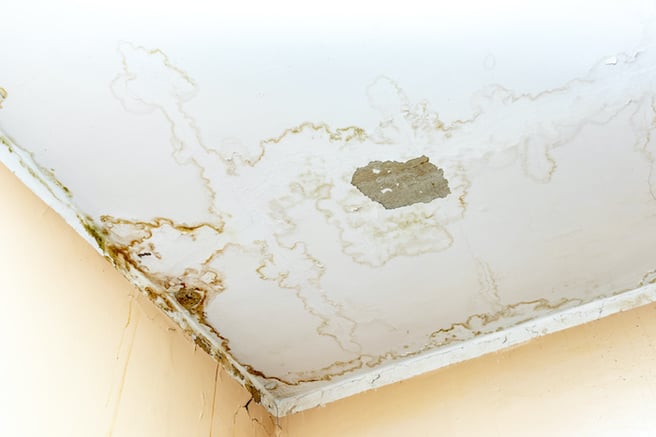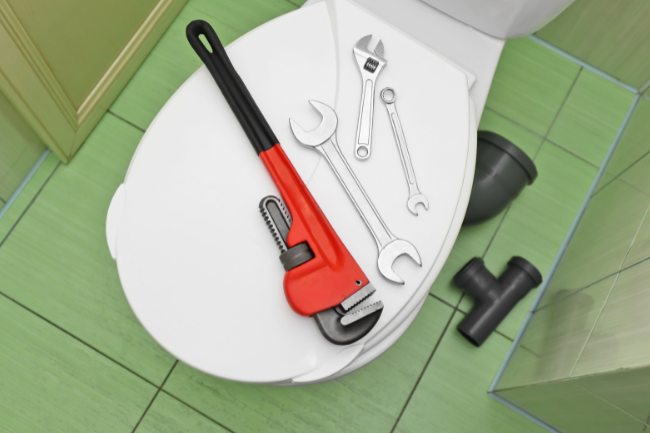3 Ways to Fix a Leaking Ceiling (+ Tips for Preventing Severe Damage)
Posted by William Heinselman on

Ceiling leaks are a plumbing issue that can be detected by blistered or peeling paint, dripping water, and discoloration on your ceiling.
A ceiling leak is a sign that there is another problem with your home plumbing system or roof.
If you notice your ceiling has these problems, you'll need to track down the source of the problem before you can proceed to fix the problem yourself or call a plumber to fix it for you.
What to Do Before You Call a Plumber
Here are some of the things to do before you call a plumber for a ceiling leak.
Clear the Area
If your ceiling is leaking, it may be causing damage to any of the belongings you have under the leak. Clear the area to make sure the water isn't causing further damage to any of your items such as furniture, electronics, clothes, or other valuables.
Clearing the area also provides you or your plumber direct access to the portion of the ceiling that is leaking. This way, you can use a ladder or a step stool to assess the problem.
Get a Bucket
Once you clear the area, place a bucket under the affected area so it can catch the dripping water from your ceiling. This prevents further damage to your flooring and provides you with a better idea of how much water is coming out.
You may notice that water is streaming continuously or only at certain times – for instance, after you flush the toilet or run the shower.
See If You Can Stop the Source of Water
You may be able to use a shut off valve to stop water from flowing into the affected pipe or pipes that are causing your ceiling to leak. You may also notice that the water is only leaking when you use a specific toilet, shower, sink, or your washing machine.
Until you are able to fix the problem, you may discontinue water usage at the source of the problem to prevent further water damage to your ceiling, floors, or walls.
Why Your Ceiling May Be Leaking
Here are some common causes of ceiling leaks.
Toilet Leak
Toilet leaks can come from the water or supply tank, but some of the most dangerous water leaks that may affect ceilings come from the worn wax ring.
Water seeps through the wax ring when you flush and may start running behind the walls, dripping down pipes, and causing water damage on your ceiling. This moistens the drywall, producing wet spots.
Shower Leak
Shower leaks may be difficult to detect at first since all of the plumbing is buried in a wall and surrounded by tiles.
Your ceiling leak may be caused by an upstairs shower if the tiles or flooring are peeling or curling near the shower. Worn out caulking or holes in water supply lines may be the culprits.
Sink Leak
You may not notice your sink is leaking until there is water pooling on the floor. By that point, the cabinet doors may be damaged and moldy at the bottom. The water leaking from your sink may be coming from:
- The supply hoses
- Damaged caulk
- Loose P-trap connectors
- A loose strainer or a strainer that needs to be replaced
Roof Leak
There are many reasons why your roof might be leaking. Some of the most common reasons include:
- Holes
- Missing or damaged shingles
- Gutter problems
- Ridge caps and valleys
- Vents, skylights, and chimneys
Roof leaks typically cause larger water spots to your ceiling that brown and grow mold quickly if left unchecked. Every time it rains, the spot may get bigger, and water may also run down your walls. You may have to go up onto your roof to assess the problem further so you can see what the leak is being caused by.
Ways to Fix Ceiling Leaks On Your Own
Here are three ways you can fix the common causes of ceiling leaks on your own.
1. Toilet Leak Repair
There are two simple ways to fix toilet leaks. The first way is to replace the wax ring, and the second way is to fix the supply tube or leaking shutoff valve.
Here are some steps you can take to fix toilet leaks:
Wax Ring:
1. Drain and remove the toilet.
2. Remove the existing wax ring.
3. Remove the toilet flange bolts.
4. Attach the new wax ring.
5. Position and bolt the toilet back to the floor.
6. Reconnect the toilet and test the new wax ring.
Supply Tube:
1. Turn off the water supply to your toilet.
2. Empty the water from the toilet.
3. Loosen the nut connecting the supply line using a wrench.
4. Install the new supply line.
5. Turn the water back on.
6. Check for leaks.
2. Shower Leak Repair
For shower leaks behind the wall, here are the steps you need to take to fix it:
1. Cut an inspection window to inspect the shower pipes.
2. Look for signs of leaking.
3. Turn on the shower to find the source of the leak. You may need a flashlight or a mirror for this.
4. Fix a leaking shower arm or valve. If the shower arm is the reason for the leaking shower, all you have to do is remove the circular metal plate unscrew the shower arm, clean the joint compound with a wire brush.
Next, wrap the threads with plumbing tape, and screw the arm back into the water pipe joint.
If it's the valve leaking, you'll have to turn off the water valve and replace the cartridge. If it is the valve body that is the problem, it is best to call a professional plumber to hep you solve the problem.
3. Sink Leak Repair
There are two main types of sink leaks that may cause a ceiling leak: water-supply leaks and drain leaks.
Here are some ways to fix sink leaks before they become a major problem:
Water-Supply Leaks:
1. If the leak is not already visible, check for the leak by wrapping toilet paper around the supply line.
2. If you notice the water coming from the supply line connection, tighten the connection with a wrench.
3. If this doesn't work, turn off the water at the supply valve. Remove the nut and spread plumber's pipe compound inside the washer fitting and onto the threads. Tighten it down again.
4. If the leak persists, you may have to replace the supply line.
Drain Pipe Leak:
1. Take out the sink outlet flange and drain pipe.
2. Inspect all parts such as the gaskets, rubber sealing, drain pipe, and nut to see if they might be cracked or if the metal or plastic threads are stripped.
3. If these items are damaged, you'll need to replace them and put the parts back together.
4. If the sink parts are not damaged, you'll need to purchase a few items to fix the problem to ensure the leak doesn't continue. You'll need plumbers tape or plumbers putty to make sure the connections are water-tight.
Who Do I Call If I Have a Severe Ceiling Leak?
Severe plumbing leaks will not get better on their own. If you have a severe leak that doesn't have a simple fix or if you can't identify where the leak is coming from, it is best to immediately contact the plumbing professionals at Express Drain & Sewer.
Even if your ceiling leak isn't bad yet, it can get bad quickly and cause unwanted mold that may affect your health adversely.
Contact Sacramento plumbers at Express today before your ceiling leak gets out of control.
Topics: Plumbing in Sacramento, Commercial Plumbing, Pipe Leaks and Repair, Home Plumbing



![How to Prevent Flooding [6 Tips to Protect Your Property]](https://www.expresssewer.com/hubfs/prevent_flood.png?width=550)



